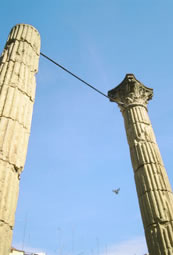
Gothic Heritage
Even though the Gothic style did not enter into the counties until the very advanced 14th century; it is possible to divide this stage in two parts: the XII-XIII centuries and the XIV-XV centuries. The first part begins with a big economic growth - the cities grow and the bourgeoisie turns up -, and the feudalism starts to yield terrain of the strong central monarchies. The Church promotes spiritual ideals focused to sustain the material poverty - first with the Cistercians and afterwards with the Franciscans and Dominicans - and the knowledge opens new possibilities dedicated to go deeply into the autonomous philosophy, which is totally separated of the theology. However, the last two centuries are those of crisis: years followed by bad harvests, hunger, plagues, military conflicts, etc.In Catalonia, the reign of Jaume II, finished in 1327, left a country in full growth. The cities had progressed a lot and Barcelona, especially, had become an important bussiness center of the Mediterranean. The new high bourgeoisie could be compared to the aristocracy in its power and decision capacity, especially in the cities where they became a new aristocracy. The conflicts between royalist groups and oligarchic groups would burst during the following years, even though in those moments the confrontation was already clear.
All this will be translated in a great constructive fever, with new architectural ideas that allowed constructing temples of bigger dimensions, higher and better illuminated; often they were promoted by the royal house but also by the more rich bourgeois people, the citizens and the guilds. The civil buildings started to renew themselfs: royal palace, town councils, shipyards, and new walls; but also new palaces for the recently enriched bourgeois who affirmed their position. Although this cultural impulse starts in the period of splendor, curiously it is from the reign of Pere III and during the 15th century, already in the medieval crisis, when we find a bigger artistic activity.
More than twenty villages of the Costa Daurada still preserve constructions corresponding to the inventory of the Catalan Gothic heritage. Some of them are Gothic in absolute way, like the Casa Paladella in Bot or the church of Santa Maria in Flix, some combine different styles, such as the cathedral of Tarragona and the church of Santa Maria de Queralt, and there are some which are part of monumental sets like the ancient kernel of Tortosa. Besides the mentioned buildings, many villages of the Cosat Daurada keep samples of Gothic architecture in shape of hospitals, palaces or convents.
